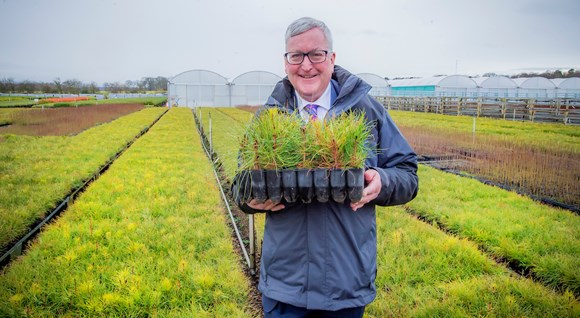11,200 hectares of new planting has been undertaken in Scotland last year, comfortably beating the current 10,000 ha annual target. Last year, 7,100 ha of new trees were planted.
The Scottish forest industry is also outstripping the rest of the UK as 84% of all new planting took place in Scotland.
The new woodland figures also confirm that the Scottish Government’s Biodiversity Route Map commitments for new native woodland creation are being met, with the establishment of around 3,900 ha of new broadleaves, around 40 per cent of all new planting in Scotland.
The future for tree planting is also looking very positive with strong demand for applications already in for the following year. The increase in planting will help fight climate change as the trees absorb substantial amounts of carbon.
Welcoming the figures, Rural Economy Secretary Fergus Ewing said:
“This is fantastic news that we’ve smashed the targets. It is testament to the Scottish Government making forestry a priority and investing and helping growing the industry.
“The whole tree planting effort has truly been a national endeavour with all forestry interests, both large and small, pulling together.
“With an increase in tree planting in the pipeline, it is now more important than ever to make sure the right trees are planted in the right places.
“A new approach to woodland creation proposals was introduced last year and whilst this has helped us deliver the target, it also ensures that communities and interest groups are consulted along the way.
“But there is also a huge environmental significance to the increase in tree planting. We are now facing a global environment emergency.
“In Scotland alone, around 9.5 million tonnes of CO2 each year are removed from the atmosphere by our forests – this is a clear example of why an increase in tree planting is so important in the fight against climate change.”
The Scottish Government has directly contributed towards surpassing the planting targets with around 1,000 ha being planted by its agency Forestry and Land Scotland in 2018/19. The remaining 10,200 hectares were planted by a range of private forestry interests.
A mixture of an improved and streamlined applications process, more promotion and better grant packages have helped boost tree planting across Scotland.
The Scottish Government, as part of their climate change commitments, has already upped the planting targets for the future, rising to 15,000 ha a year from 2024/25.
Scotland’s forests cover 18.7% of the total land mass area and the ambition contained in Scottish Government’s forestry strategy is to increase this to 21 % by 2032.
Stuart Goodall, Chief Executive of Confor, which represents the forestry and wood processing sector, said:
“I’m really pleased we’ve hit our planting targets in Scotland.
“This is great news for the sector, but also for all Scotland now that the First Minister has announced a climate emergency.
“Planting trees locks up carbon and by harvesting and replanting them sustainably, we can produce an infinitely renewable supply of wood with which to build homes and to manufacture an array of everyday products – while also reducing carbon in the atmosphere.
“Scotland is leading the way in the UK, with 84 per cent of all new planting happening in Scotland. Confor has worked long and hard with the Scottish Government to get to this point and I truly hope the momentum will be maintained in the coming years. We now need the rest of the UK to move beyond ramped-up rhetoric on a climate emergency and begin to take the positive action that we see in Scotland.”
Dr Sam Gardner, deputy director at WWF Scotland added:
“Woodlands will play an increasingly important role in capturing carbon and reducing Scotland’s contribution to climate change. These statistics show that Scotland can not only meet its own targets, while also making a significant contribution to the UK’s response to the climate emergency.
“We need to ramp up these efforts to meet the scale of the challenge but do so in a sustainable and integrated way, capturing carbon and delivering nature rich productive woodlands.”
Carol Evans, Director of Woodland Trust Scotland said:
“The urgency for action on climate change is starting to hit home. At the same time the role trees can play in soaking up carbon is also becoming more generally recognised.
“Scotland has been ahead of the curve on this compared to the rest of the UK and we are absolutely delighted that the planting targets have finally been met. We need to keep this momentum going. We need to both expand the area of Scotland’s woods and significantly improve the condition of the forest habitats we already have. Suitably managed native woods can be the nation’s green lungs. Native trees are often planted for longevity and therefore lock up carbon for longer.”




